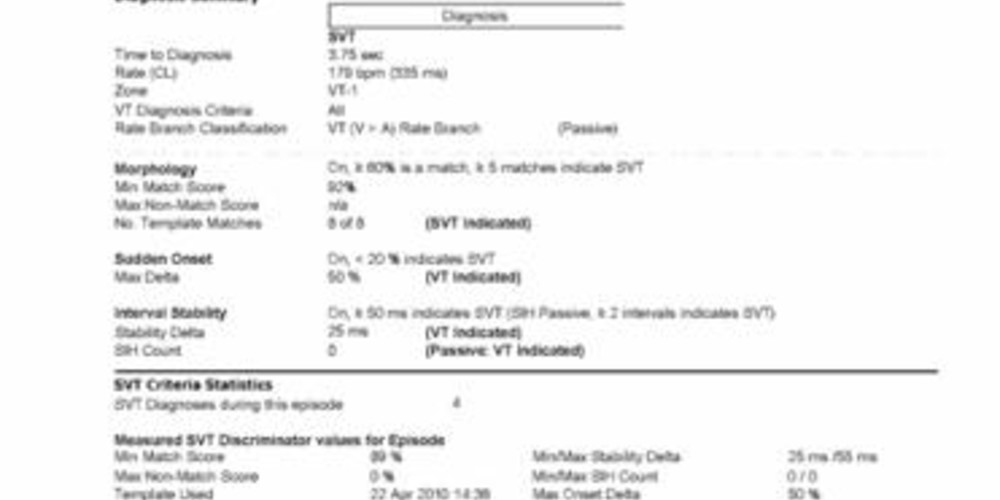Single chamber discrimination by triple chamber defibrillator
Tracing
Manufacturer Abbott
Device ICD
Field Discrimination
N° 44
Patient
This 66-year-old recipient of a Abbott Promote Accel CRT-D implanted for advanced dilated cardiomyopathy with a 30% LVEF and New York Heart Association functional class III, underwent His bundle ablation for chronic AF and was seen for a routine follow-up visit.
Main programmed parameters
- VF zone at 222 bpm, VT zone-2 at 190 bpm and VT zone-1 at 160 bpm
- 12 cycles in the VF zone, 12 cycles in the VT zone-2 and 12 cycles in the VT zone are needed for the diagnosis
- Effective discrimination programmed in the VT zone-1 and VT zone-2
- Criteria for VT diagnosis: all criteria
- Morphology: ON (60%; 5 out of 8)
- Stability: ON 50 ms; detection window: 12 intervals
- SIH: passive, 2 intervals
- Sudden onset: ON, 20%

Graph and trace
Narrative
Episode diagnosed as SVT by the defibrillator; all single chamber discrimination criteria (3 out of 3) were needed for the diagnosis of VT; the morphology criterion is in favor of SVT; the stability and sudden onset criteria are in favor of VT; therefore, no therapy was delivered; the classification per arm (dual chamber discrimination) was set on passive and was not applied in the discrimination.
Tracing
- biventricular paced rhythm at the sensor-indicated rate (SIR);
- onset of ventricular tachycardia (patient pacemaker-dependent); the first cycles are classified VS or are unclassified;
- first cycle classified in the tachycardia or fibrillation zone of the episode (in this case T1). The gradual versus sudden onset of the arrhythmia is ascertained from this pivotal cycle onward; it is also from this cycle that the number of sinus and unclassified intervals included in the SIH counter are counted; 12 cycles elapse until the diagnosis is made; stability is analyzed during these 12 cycles;
- from this complex onward, 8 cycles elapse before the diagnosis; morphology is analyzed during these 8 cycles;
- once the VT counter full, the diagnosis is made (12 cycles classified T1 since the previous return of sinus rhythm); the 8 ventricular electrograms analyzed by the morphology criterion were considered similar (ν), since the percentage of similarity was consistently above the programmed 60% threshold, favoring SVT. Out of the 12 analyzed cycles, the second shortest and the second longest are measured at, respectively, 324 and 352 ms, representing a 28 ms delta (rounded down to 25 ms). This criterion is in favor of VT; the SIH counter, at 0, is also in favor of VT, though was not included in the analysis because on passive mode; sudden onset was in favor of VT. Despite 2 criteria in favor of VT, therapy was not delivered, as the VT diagnosis required the fulfillment of 3 criteria;
- redetection after 6 T1 cycles; diagnosis of SVT because of similar morphology;
- spontaneous termination of tachycardia and diagnosis of return to sinus rhythm after 3 biventricular paced events (BP) or ventricular stimuli (VS).
Other articles that may be of interest to you






Single chamber discrimination is also available in double or triple chamber devices and might be useful in cases of loss of atrial sensing or development of permanent AF.
This tracing illustrates 2 important points: 1) this patient had undergone His bundle ablation and is totally dependent on his device. All spontaneous rapid rhythms are ventricular in origin and no additional discrimination is necessary. However, the discrimination parameters may be misleading. With a percentage of similarity near 100%, the morphology criterion is in favor of SVT, as the device probably used an ectopic complex for reference; 2) the device diagnosed SVT and no therapy was delivered. The delivery of therapy would have been appropriate from the standpoint of discrimination, though unnecessary since, after a few seconds, the arrhythmia ended spontaneously. In this patient, it might be appropriate to deactivate the discrimination parameters as well increase the number of cycles needed for the diagnosis of VT to promote its spontaneous termination.